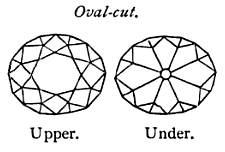Oval Cut Diamond
The modern Oval Cut Diamond typically has the same number of facets (58 including culet and not including girdle facets) as the Round Brilliant - and these are in the same configuration. The oval cut diamond's shape is oval, rather than round, when viewed from directly above the crown. Oval cut diamonds, like other modern diamond shapes, are designed to maximise brilliance and other light performance characteristics in the stone.
The modern oval cut diamond, also known as the oval brilliant cut or oval modified brilliant, is recorded as having been invented in 1960 by Lazare Kaplan. [1] However this needs some clarification, because diamonds have been fashioned into oval shapes since old times - and the term "oval cut" has been applied to diamonds since at least the 19th century. Alexander Hay Japp's 1889 text " Days with industrials: adventures and experiences among curious industries" has a diagram of several diamond cuts of the day [2] , including an oval cut diamond of 33 crown facets, 24 pavilion facets and culet for a total of 58. The antique oval cut diagram from Happ's book is reproduced here.
Happ's oval cut diamond is quite similar to the modern brilliant oval cut gem - the chief difference being that the lower girdle and pavilion main facets are monger and thinner in modern gems. The antique oval cut can be seen as an oval form of Old Mine Cut.
Some of the most famous diamonds of ancient times were cut into oval shapes. The legendary Koh-i-noor diamond was fashioned into a most unusual oval shape - flat underneath, with triangular facets above, and in an approximate overall oval form. Also Sir Edward Thomason's Memoirs of 1845 has an entry describing a famous oval diamond - the Blue Hope:

Drawing of antique oval cut diamond from 1889.
"Mr. Elliason, the great diamond merchant, residing in London, in 1821 (the year of the coronation of George IV.), was possessed of a very fine oval diamond of a sky blue, and of intense brilliancy. It was cut and polished as a brilliant, and its play of colour was matchless. In spread it was two-thirds the size of the Piggot diamond, being a little thinner, which the colour made up for; and it was of the same oval form." [3]
Thus it can be seen that the oval shape has been used in diamond cutting for centuries, quite possibly with a view to maximizing the weight of the finished stone. However the earliest stones were not uniform in their facet pattern and number of facets; they would have had varying patterns of facets appropriate to the technology of the day, the original shape and size of the rough diamond and the skill of the cutter. In general, diamond shapes have become ever more complex, precise and "standardized" through the passage of time and the "eccentric" cuts given to famous diamonds such as the Koh-i-noor would likely been seen as a travesty if applied to a modern diamond.
Choosing An Oval Cut Diamond
For those considering purchase, an important measurement for the oval cut stone is the length to width ratio. Most oval cut stones will fall between 1.4:1 and 1.6:1. It is generally considered that a length to width ratio of around 1.5:1 is most pleasing to the eye, however the individual's taste may find a more extreme size appealing. [1] If the ratio of the oval cut diamond is greater that 1.5:1, a dark "bow-tie effect" may appear - a dark area in the diamond the shape of a bow tie. [4] This is considered undesirable and any oval cut diamond should have minimal bow-tie effect.
Another factor to consider is that not all "ovals" are exactly the same shape. Some are more perfectly elliptical (an ellipse is a mathematically perfect oval), whereas others may have ends that are flatter. In general, the shape of the oval should be graceful and appealing to the eye - and of course the stone should have good brilliance and clarity. It's also said that the oval cut stone may be more revealing of inclusions than other shapes
As with the Marquise Cut Diamond, the oval is often set "cross-wise" in a ring in order to flatter and draw attention to the length and grace of the fingers.
AGA (Accredited Gem Appraisers) has published guidelines for the oval cut diamond, giving statistics for ideal cut, premium cut, international fine trade cut, US domestic average cut and below average. In the ideal cut stone, the Table is 55-60%, Crown Height 12-15%, Girdle thickness V. Thin to Sl. Thick (0.4%-4.5%) or Thin to Thick (1%-5.5%), Total Depth 59.0-63.0%, Length to Width Ratio 1.33-1.66. Polish / Symmetry is not considered a primary determining factor but is quoted as "Excellent to Good".

See more Diamond cuts
Oval Cut Diamond info sources:
[1] http://www.buyingaloosediamond.com/oval-diamond.html
[2] http://books.google.com/books?id=sFkuAAAAYAAJ&pg=PA246
[2] http://books.google.com/books?id=22QFAAAAYAAJ&pg=PA134
[3] http://www.loosediamondsreviews.com/ovaldiamonds.html
Note - this website is intended for general informational and entertainment purposes, and should not be considered to be professional consultation. If you are considering purchasing precious stones, be sure to seek the advice of a qualified professional.

